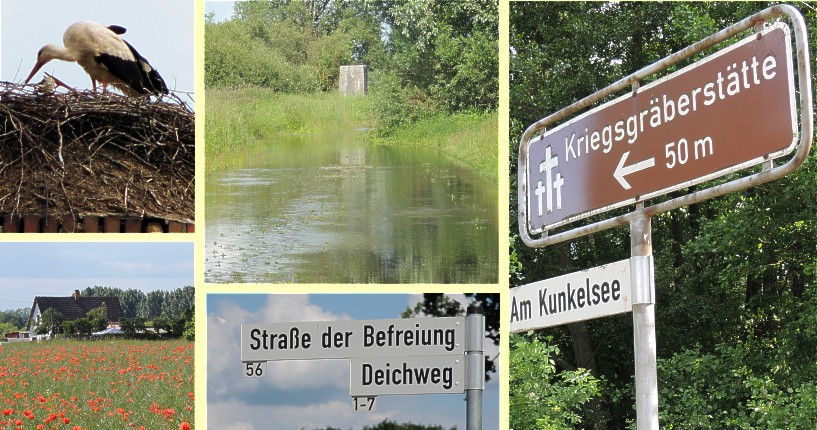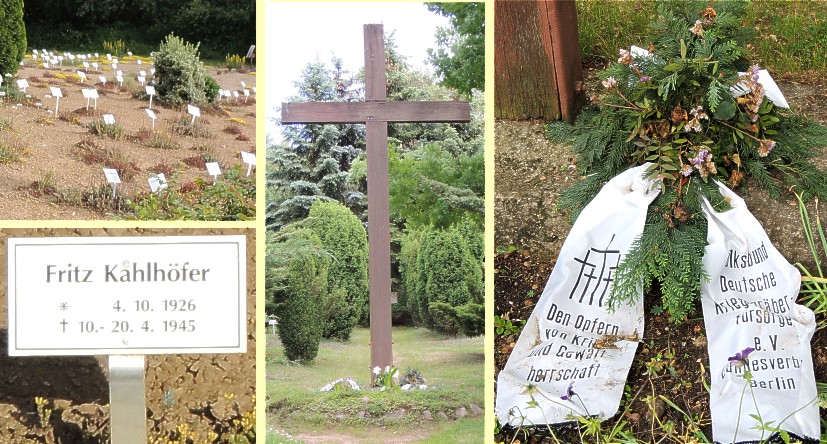Kansas Snapshots by Gloria Freeland - June 21, 2013
A quiet hillside
After more than a week of spending our days in Berlin, husband Art and I were ready for some time away. We also wanted the day to be as
unscheduled as possible, so we lingered at the place in the woods friend Matthias had provided as our German "home away from home." It was
almost 2 p.m. when we climbed into our rented car. But the long days of summer meant there was no need to rush.
Our destination was the Oderbruch, a farming region just inside Germany's northeast border. To the east across the wide Oder River lies
Poland.
The vast fields filled with green wheat, oats and hay were somehow rejuvenating for this Kansas farm girl. Orange poppies and blue bachelor's
buttons were sprinkled along the edges of the roads and throughout the fields. We paused in the village of Trebnitz to watch a stork tend to its
youngster in a nest built on the top of an old chimney. The only other sign of life in the nicely-kept town was the two-car train that passed
through quickly without stopping.
Perhaps because I grew up in a place where large amounts of water are uncommon, I love the ocean, lakes and rivers. So I was looking forward
to our stop on the banks of the Oder just east of Kienitz where we had walked out on a small peninsula in past years. But the area had experienced
heavy rains this spring and the roadway to the river's bank was flooded, requiring that we turn back.
Time seemed to pass quickly. My interest in the green fields began to compete with thoughts of the Thai restaurant in Furstenwalde not far
from our home base. So Art used his GPS to guide us in that general direction while choosing roads we had never been on before.
As we approached the small village of Lietzen, we passed a sign for a war cemetery pointing along a lane on the left side of the road.
"You want to stop and take a look?" Art asked.
Since he was already slowing down, I knew he did.
As we pulled into the lane, it became obvious that it was only 50 feet or so long. The building we had first taken to be a small home was a
chapel. The nearby hillside was peppered with small markers like those used in gardens to identify vegetables.
But as we began to walk the hillside, it was clear they were grave markers. Most had a full name and birth date preceded by a small sun symbol,
followed by a death date marked with a cross. Here and there, several names appeared on a single marker. Some were for men well past the
prime of life, while others were for youngsters who scarcely qualified to be called men. One thing they had in common was that they all died
during the early spring of 1945.
"This makes no sense to me," Art said. "This is not a place there would have been a big battle. And even if it had, as the Russian Army pressed
on to Berlin, no one would have stopped to bury dead Germans."
Looking through the windows of the locked chapel, we saw furled banners at the end of the room opposite the door. One had opened enough that we
could read "Our fallen sons" in German. The chapel also contained a few chairs and a large number of what appeared to be small coffins made
from heavy charcoal-gray cardboard. Each contained a handwritten number. Cut cardboard forms ready to be folded were stacked nearby.
That evening, a little research on the Internet provided some answers. In the spring of 1945, the Red Army was pushing its way toward Berlin,
approaching from the flat plains created by the Oder River. The Germans held the overlooking heights. But the Russians had a seemingly
unlimited number of men. By 1945, German manpower was almost gone. More than two Russian soldiers died for every German, but the Red Army won the
battle. The road to Berlin was then almost unobstructed. The dead were pushed into bomb craters and covered to prevent the spread of disease.
Russian soldiers carried virtually no identification, so when their remains are unearthed, they usually cannot be identified. But German
soldiers had identification tags, and the cemetery by Lietzen was opened in 2003 to provide a final resting place for them. Unlike in the U.S.,
German cemetery plots are sold only for a limited time, often 25 years. Then they are resold. But the graves for soldiers in war cemeteries are
permanent, so families prefer their service members be buried in such a place.
Reflecting on our trip through the Oderbruch, it struck me how despite World War II ending more than 68 years ago, its effect lingers
everywhere in Germany. Any major construction involves a call to experts who check the ground for unexploded bombs or shells. A foundation
for a new home must be dug carefully as the remains of soldiers are often discovered. The small road leading from the river in Kienitz is named
"Strasse der Befreiung" - street of liberation - as it was there that Soviet tanks first rumbled into Germany's heartland. Sprinkled across
Germany are signs pointing the way to former concentration camps. Many historic buildings have signs that inform visitors of what parts had to
be rebuilt after the war. Remnants of the Berlin Wall - which came down only 24 years ago - are a major tourist attraction. Wandering near the
Brandenburg Gate, visitors might encounter street vendors selling war "memorabilia" - much of questionable authenticity - such as Red Army officer
hats.
Sociologists have pointed to the strange effect this history has had on the people of this now-prosperous country. Germany has contributed
much to Western culture, while also creating several of its darkest stains.
Yet none of that matters to the families of soldiers buried in the simple graves outside of Lietzen. Services are simple affairs devoid of
military references. Few, if any, of these men were the hard-core believers seen in the old black-and-white movies of the late 1930s. They were
just men, young and old, who wanted to go home, but instead ended up on a quiet sloping hillside on the edge of a small village in the Oderbruch.

